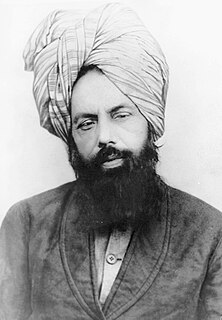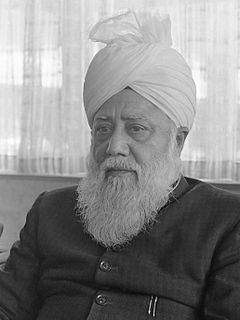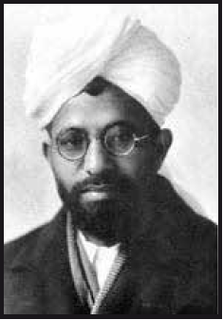
Mirzā Ghulām Ahmad was an Indian religious leader and the founder of the Ahmadiyya Movement in Islam. He claimed to have been divinely appointed as the promised Messiah and Mahdi—which is the metaphorical second-coming of Jesus (mathīl-iʿIsā), in fulfillment of Islam's latter day prophecies, as well as the Mujaddid of the 14th Islamic century.

The Lahore Ahmadiyya Movement for the Propagation of Islam, is a separatist group within the Ahmadiyya movement that formed in 1914 as a result of ideological and administrative differences following the demise of Hakim Nur-ud-Din, the first Caliph after Mirza Ghulam Ahmad. Members of the Lahore Ahmadiyya movement are referred to by the majority group as ghayr mubāyi'īn and are also known colloquially as Lahori Ahmadis or Lahoris.

The Ahmadiyya Caliphate is a non-political caliphate established on May 27, 1908 following the death of Mirza Ghulam Ahmad, the founder of the Ahmadiyya Muslim Community, who claimed to be the promised Messiah and Mahdi, the expected redeemer awaited by Muslims. It is believed by Ahmadis to be the re-establishment of the Rashidun Caliphate that commenced following the death of the Islamic prophet Muhammad. The caliphs are entitled Khalīfatul Masīh, sometimes simply referred to as Khalifa. The caliph is the elected spiritual and organizational leader of the worldwide Ahmadiyya Muslim Community and is the successor of Ghulam Ahmad. He is believed by the Community to be divinely ordained and is also referred to by its members as Amir al-Mu'minin and Imam Jama'at. The 5th and current caliph is Mirza Masroor Ahmad.

Mirza Tahir Ahmad was the fourth caliph and the head of the worldwide Ahmadiyya Muslim Community. He was elected as the fourth successor of the founder of the community Mirza Ghulam Ahmad on 10 June 1982, the day after the death of his predecessor, Mirza Nasir Ahmad.

Hāfiz Mirza Nasir Ahmad was the third caliph, head of the Ahmadiyya Muslim Community. He was elected as the third successor of Mirza Ghulam Ahmad on 8 November 1965, the day after the death of his predecessor and father, Mirza Basheer-ud-Din Mahmood Ahmad.

Mirza Basheer-ud-Din Mahmood Ahmad, was the second caliph, leader of the worldwide Ahmadiyya Muslim Community and the eldest son of Mirza Ghulam Ahmad from his second wife, Nusrat Jahan Begum. He was elected as the second successor of Mirza Ghulam Ahmad on 14 March 1914 at the age of 25, the day after the death of his predecessor Hakim Nur-ud-Din.

The Fazl Mosque, also known as The London Mosque, is the first purpose-built mosque in the British capital. It was inaugurated on 23 October 1926 in Southfields, Wandsworth. At a cost of £6,223, the construction of the mosque and the purchase of the land on which it sits, was financed entirely by the donations of Ahmadi Muslim women in Qadian, India. Since 1984, the Fazl Mosque has been the residence of the caliphs of the Ahmadiyya Muslim Community, and therefore, its de facto international headquarters.

Khwaja Kamal-ud-Din, a lawyer by profession, was a prominent figure of the early Ahmadiyya movement. He was the first Muslim missionary to Britain and the author of numerous works about Islam.

Jalsa Salana is the formal, annual gathering of the Ahmadiyya Muslim Community initiated by Mirza Ghulam Ahmad, founder of the community who claimed to be the Promised Messiah and Mahdi of the end days. Usually, the gathering spans over three days, beginning on Friday after the Friday Sermon. Typically, the flag hoisting ceremony is used to identify its commencement. Although there is a central, international Jalsa attended by Ahmadis from across the world, many of the countries hold their own national jalsa, sometimes attended by the Khalifatul Masih.

Ahmadiyya is an Islamic movement in Indonesia. The earliest history of the Community in Indonesia dates back to the early days of the Second Caliph, when during the summer of 1925, roughly two decades prior to the Indonesian revolution, a missionary of the Community, Rahmat Ali, stepped on Indonesia's largest island, Sumatra, and established the movement with 13 devotees in Tapaktuan, in the province of Aceh. The Community has an influential history in Indonesia's religious development, yet in the modern times it has faced increasing intolerance from religious establishments in the country and physical hostilities from radical Muslim groups. The Association of Religion Data Archives estimates around 400,000 Ahmadi Muslims, spread over 542 branches across the country.
The family of Mirza Ghulam Ahmad originated in Samarqand in what is today Uzbekistan and had settled in the Punjab, India in the 16th century. The family held authority over the fortified hamlet of Qadian and surrounding villages since the time of Emperor Babur, and formed the elite of the Mughal Empire, but lost most of its estate following the rise of the Sikh Empire in the region.
The Islamic Review (1913–1971) was an Ahmadiyya official magazine, first of the Woking Muslim Mission, and then of AAIIL, California (1980–1989). It was founded in London by Khwaja Kamal-ud-Din. Originally the Muslim India and Islamic Review, the name was changed in 1914 to Islamic Review and Muslim India to reflect broader Islamic concerns, and in 1921 became simply the Islamic Review. The magazine gained popularity among the English-speaking Muslim social elite in Europe, the USA and throughout the British Empire, and in some of the countries it was circulated, its articles were reprinted and quoted in local Muslim newspapers.

Abdur Rahim Dard, known as A. R. Dard was an Ahmadi Muslim writer, missionary, and political activist for the Pakistan Movement, who served as the Imam of the historic Fazl Mosque, the premier gathering place for Indian Muslims regardless of denomination in London. He is known for convincing Muhammad Ali Jinnah to return to British India and fight for the Pakistan Movement.

The Ahmadiyya movement in Islam has relationships with a number of other religions. Ahmadiyya consider themselves to be Muslim, but are not regarded as Muslim by mainstream Islam.

Ahmadiyya is an Islamic community in Afghanistan, under the leadership of the caliph in London. The earliest contact with the Ahmadiyya movement in Islam and the Pashtun people within modern-day boundaries of Afghanistan, occurred during the lifetime of Mirza Ghulam Ahmad. The movement began by Ahmad, was largely seen as apostasy by most other Muslim groups, including by those in Afghanistan, and accordingly only twelve years after Ahmad's claim of Mahdi-hood, two of the foremost Ahmadi Muslims were stoned to death in Kabul during 1901 to 1903. The killings continued until 1925, when in 1924-1925, under Emir Amanullah Khan affiliation with Ahmadiyya beliefs became a capital offence and those who converted were forcibly reverted.

Ahmadiyya is an Islamic movement in Australia, first formally founded in the country in the 1980s, during the era of the fourth caliph. However, the history of the Community dates back to the early 20th century, during the lifetime of the founder of the movement, Mirza Ghulam Ahmad, with the first contacts arising as a consequence of Australians travelling to British India, and also as a consequence of early, "Afghan" camel drivers settling in Australia during the mid to late 19th century. Today there are at least four mosques, in four of the six Australian states, representing an estimated 3,000 Australian Ahmadi Muslims in the country.

Al-Hajj Abdul Rahim Nayyar was a companion of Mirza Ghulam Ahmad and a missionary of the Ahmadiyya Islamic movement in West Africa. He pledged allegiance to Ghulam Ahmad, formally joining the Ahmadiyya movement, in 1901. Travelling to the Gold Coast in 1921 upon invitation from Muslims in Saltpond, Nayyar was instrumental in consolidating Ahmadiyya missions in several West African countries.

The Ahmadiyya is an Islamic movement in Egypt with origins in the Indian subcontinent. Although the earliest contact between Egyptians and the Ahmadiyya movement was during the lifetime of Mirza Ghulam Ahmad, its founder, the movement in Egypt was formally established in 1922 under the leadership of its second Caliph Opposition to the Ahmadiyya grew particularly in the latter part the 20th century and Ahmadis have seen increased hostility in Egypt more recently. There are up to 50,000 Ahmadi Muslims in Egypt. Although the group is not officially recognised by the state.
















